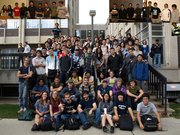09-240:HW2: Difference between revisions
From Drorbn
Jump to navigationJump to search
No edit summary |
m (117,648 = 7^6 - 1) |
||
| (2 intermediate revisions by one other user not shown) | |||
| Line 1: | Line 1: | ||
{{09-240/Navigation}} |
{{09-240/Navigation}} |
||
{{In Preparation}} |
|||
Read sections 1.1 through 1.3 in our textbook, and solve the following problems: |
Read sections 1.1 through 1.3 in our textbook, and solve the following problems: |
||
| Line 6: | Line 5: | ||
* Problems <u>3a</u> and 3bcd on page 6, problems <u>1</u>, 7, <u>18</u>, 19 and <u>21</u> on pages 14-16 and problems <u>8</u>, 9, 11 and <u>19</u> on pages 20-21. You need to submit only the underlined problems. |
* Problems <u>3a</u> and 3bcd on page 6, problems <u>1</u>, 7, <u>18</u>, 19 and <u>21</u> on pages 14-16 and problems <u>8</u>, 9, 11 and <u>19</u> on pages 20-21. You need to submit only the underlined problems. |
||
* Note that the numbers <math>1^6-1=0</math>, <math>2^6-1=63</math>, <math>3^6-1=728</math>, <math>4^6-1=4,095</math>, <math>5^6-1=15,624</math> and <math>6^6-1= |
* Note that the numbers <math>1^6-1=0</math>, <math>2^6-1=63</math>, <math>3^6-1=728</math>, <math>4^6-1=4,095</math>, <math>5^6-1=15,624</math> and <math>6^6-1=46,655</math> are all divisible by <math>7</math>. The following four part exercise explains that this is not a coincidence. But first, let <math>p</math> be some odd prime number and let <math>{\mathbb F}_p</math> be the field with p elements as defined in class. |
||
*# Prove that the product <math>b:=1\cdot 2\cdot\ldots\cdot(p-2)\cdot(p-1)</math> is a non-zero element of <math>{\mathbb F}_p</math>. |
*# Prove that the product <math>b:=1\cdot 2\cdot\ldots\cdot(p-2)\cdot(p-1)</math> is a non-zero element of <math>{\mathbb F}_p</math>. |
||
*# Let <math>a</math> be a non-zero element of <math>{\mathbb F}_p</math>. Prove that the sets <math>\{1,2,\ldots,(p-1)\}</math> and <math>\{1a,2a,\ldots,(p-1)a\}</math> are the same (though their elements may be listed here in a different order). |
*# Let <math>a</math> be a non-zero element of <math>{\mathbb F}_p</math>. Prove that the sets <math>\{1,2,\ldots,(p-1)\}</math> and <math>\{1a,2a,\ldots,(p-1)a\}</math> are the same (though their elements may be listed here in a different order). |
||
| Line 13: | Line 12: | ||
You don't need to submit this exercise at all, but you will learn a lot by doing it! |
You don't need to submit this exercise at all, but you will learn a lot by doing it! |
||
This assignment is due at the tutorials on Thursday |
This assignment is due at the tutorials on Thursday October 1. Here and everywhere, '''neatness counts!!''' You may be brilliant and you may mean just the right things, but if the teaching assistants will be having hard time deciphering your work they will give up and assume it is wrong. |
||
Latest revision as of 22:18, 6 December 2009
| ||||||||||||||||||||||||||||||||||||||||||||||||||||||||||||||||||
Read sections 1.1 through 1.3 in our textbook, and solve the following problems:
- Problems 3a and 3bcd on page 6, problems 1, 7, 18, 19 and 21 on pages 14-16 and problems 8, 9, 11 and 19 on pages 20-21. You need to submit only the underlined problems.
- Note that the numbers , , , , and are all divisible by . The following four part exercise explains that this is not a coincidence. But first, let be some odd prime number and let be the field with p elements as defined in class.
- Prove that the product is a non-zero element of .
- Let be a non-zero element of . Prove that the sets and are the same (though their elements may be listed here in a different order).
- With and as in the previous two parts, show that in , and therefore in .
- How does this explain the fact that is divisible by ?
You don't need to submit this exercise at all, but you will learn a lot by doing it!
This assignment is due at the tutorials on Thursday October 1. Here and everywhere, neatness counts!! You may be brilliant and you may mean just the right things, but if the teaching assistants will be having hard time deciphering your work they will give up and assume it is wrong.

















